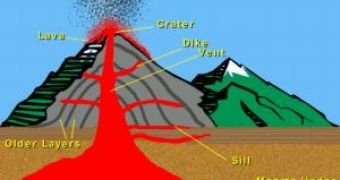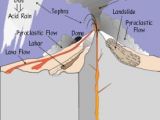During the antiquity, people attributed to the volcanoes a supernatural personality, which was worshiped.
Now, researchers just focus on achieving the right methods of preventing the volcanic eruptions and decreasing the damages they inflict.
Under the terrestrial crust, the rocks are under molten stage, forming the magma.
The huge tectonic plates, which make up the massive foundation of the continents and the bottom of the oceans, tightly bound, float over the very dense magma.
The volcanoes emerge in the points where the magma finds a way to gush away, a fracture in the terrestrial crust or more often, a place where the tectonic plates combine or diverge.
Even so, the volcanoes appear in those spots where, due to movements in the terrestrial crust, instability conditions appear.
There is the so called "Pacific Fire Circle" which compasses the largest number of active volcanoes, from Japan to Philippines and Java and from Alaska to Argentina along the western part of the Americas.
Many times, the divergence points are submarine, like in the middle of the Atlantic, and most of the volcanoes are submarine, but they can sometimes be terrestrial when they form volcanic islands (like Iceland or Hawaii).
The classical volcano has the form of a cone (stratovolcano).
The lava (how the magma that left the center of the Earth is named) gushes to the surface through a chimney which ends into a funnel-shaped crater located on the top of the volcano.
When inside the crater, a smaller cone appears; the main crater is named caldera.
The main product expelled by the volcano is the lava, formed by molten rock.
There is also the spongy rock, light fragments of porous solid rock.
The volcanic "bombs" are lava pieces almost solidified.
The volcanic ash is made by solid fragments of microscopic dimensions.
The gases spit out by the lava can spread into the atmosphere but when they are heavier than the air, they flow over the volcano's slopes like torrents that kill anything in their way.
The way the volcano is turned on varies.
Sometimes, the lava just flows over the slopes after filling the crate with a magma lake.
Sometimes, the volcano explodes repeatedly spitting off ash clouds.
In more violent explosions, "bombs" are thrown.
In some cases, very powerful explosions just blow out the upper part of the volcano.

 14 DAY TRIAL //
14 DAY TRIAL // 
